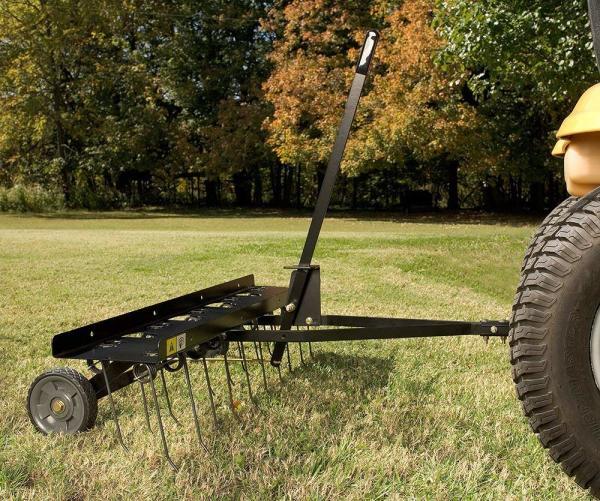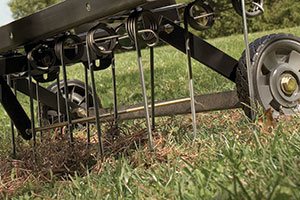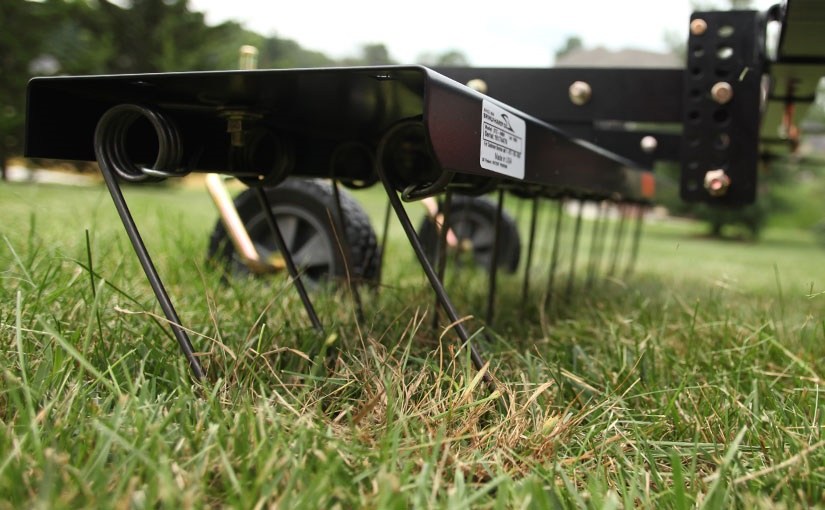
First Things First: What is a Dethatcher?
Simply put, a dethatcher is a device that effectively removes thatch from your lawn. A dethatcher can be as simple as a rake, towed behind your tractor, or even motorized for commercial jobs. A dethatcher uses metal blades or tines to comb across the grass and pull thatch up to the surface of the lawn. After the thatch is pulled to the surface, it can be bagged up or turned into compost.
Be your own lawn care expert when you learn to dethatch your lawn correctly. You can damage your yard if you don’t use the right tools on your lawn, as well as if you dethatch in the wrong season.
Lawn dethatching is a multistep process that includes:
- Mowing your lawn
- Using a dethatcher to pull up thatch
- Raking away excess thatch
- Reseeding or overseeding if needed
- Fertilizing your lawn.
What’s the Big Deal about Thatch?
Thatch is that layer between the grass line and the soil. It consists of dead and alive grass pieces, leaves, and roots. A half-inch of thatch isn’t a big deal. Matter of fact, it’s normal depending on what type of grass you plant.
Thatch becomes a problem when it’s over a half-inch thick. Turf pros say that ¾” and over of thatch is too much. You can tell if your lawn has too much thatch when

- Your lawn grass is brown and spotty. Browning turf signals that it’s not getting enough water. The thatch acts like a sponge prohibiting water from reaching the soil level.
- Your lawn is spongy. If your yard grass is squishy or spongy, it could be a sign of too much thatch. Instead of allowing water to penetrate into the ground, thick thatch absorbs water like a sponge.
- You can take samples of turf to see if you have too much thatch. You need a trowel or a bulb planter. Take your trowel down into the soil and cut out a sample consisting of grass, thatch, and soil.
You need to collect samples throughout your property to see if thatch is a problem elsewhere.
When you look at the turf slice, if there’s yellow or brown debris between the grass and the soil that is the thatch. You can measure its thickness to see if it exceeds the half-inch mark.
Learn more: Healthy Lawn Care Tips.
How to Dethatch Your Lawn Correctly
Before you learn how to dethatch your lawn, you need to learn when to dethatch your property. You dethatch your yard when your turf is actively growing.
Most experts will advise you to dethatch in early spring or early fall if you have cool season grasses. If you have warm season grasses, you want to dethatch in the late spring throughout the early summer.
Yet, there are times when you dethatch your lawn, and it causes more problems. For example, some turf pros recommend that you don’t dethatch your cool season lawn in early spring.
The young grass is coming out of dormancy and may have winter injury, including snow mold, winterkill (when ice forms on the grass plant and keeps the turf frozen for a few weeks), and other snow injuries. So, dethatching further stresses the young grass plants, killing them in the process.
It’s better to wait until the grass can be mowed before you begin a dethatching project.
Here are seven lawn dethatching tips:
- You need a dethatcher or a power rake.
- Mow your lawn at half its normal height.
- Hook up your yard dethatcher to your garden tractor.
- The dethatcher’s tines will go into the thatch and pull it up.
- Rake up the thatch that the dethatcher pulled up.
- If you notice bare patches, overseed those areas.
- Fertilize your lawn to help with recovery.
The Difference between Aeration and Dethatching
Dethatching isn’t the same thing as aeration. Each lawn care task takes care of a different problem. For example, dethatching works for thatch and you aerate your lawn if you have compacted soil.
How do you know your soil is compacted? You have a lot of foot traffic in your yard—whether that’s your teen parking their car on the lawn, your children riding their bikes in the yard, or it’s the weekly football game on Sunday.
If you have a lot going on your lawn, you probably have compacted soil. You can test your soil by walking on it—does it feel like you have concrete for soil? Can you put a screwdriver into the soil easily? If not, then, your soil is compacted.
Dethatching and aeration are generally done at the same time during the growing season. You can aerate cool season lawns in early spring or late summer/early fall. Conversely, if you have warm season grasses, you’ll aerate your yard from spring through early summer.
Learn more: You can make your own compost with kitchen scraps!
If you have compacted soil and you aerate it, you’ll notice that your aerator does double duty of pulling out thatch while it’s pulling up soil plugs at the same time. However, don’t aerate your backyard to dethatch it, or you’ll damage your lawn.
7 Lawn Care Tips
If you don’t want to dethatch your yard every season, here are seven lawn care tips to avoid excess thatch:
- Cut back on how much fertilizer you use. Too much nutrition leads to thatch development. Plus, excess fertilizer washes into stormwater drains.
- Recycle your grass clippings when you mow. It’s a myth that grass clippings cause thatch. Instead, recycled clippings add a shot of nutrition to your soil.
- Practice smart lawn care habits, such as don’t scalp your lawn.
- Mow high. Raise your mower blades to a higher setting so that you’re only taking the top third off each time you mow.
- Make sure you water your lawn deeply and infrequently. Your turfgrass needs 1” to 2” of water per week. If you have rain on any given week, you take the rainfall total and subtract it from 2”. The answer reveals how much water your lawn needs for that particular week.
- Plant grass seed appropriate for your property. If you have a shaded backyard for most of the day, then you should use shade-tolerant grass seed. Conversely, if your lawn is in full sun for most of the day, then you need grass seed for full sun.
- Get a soil test before you put on any fertilizer and soil amendments. You can buy soil test kits through your local state extension, at garden centers, or at big box stores.
Your soil test results guide you on how much of each nutrient your yard grass needs as well as if it needs any soil amendments like lime or gypsum.
Brinly-Hardy Lawn Care and Garden Attachments Help You Dethatch Your Lawn
At Brinly-Hardy, we’re passionate about DIY lawn care. Our lawn care and garden attachments help you dethatch, aerate, and clean-up your lawn.
Check out how Donald Cassidy uses his Brinly 48″ Dethatcher!
Get your own Brinly 40 inch or 48 inch dethatcher today! If you can’t find a Brinly lawn care or garden attachment, contact our customer service at 877-728-8224 or fill out our contact form and someone will contact you shortly.


